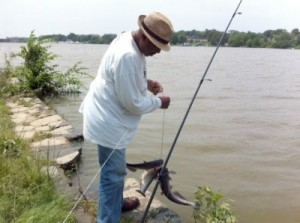Fishing in the Anacostia a Dangerous Alternative for the Hungry

Courtesy of: Jessica Gould
Bobby Jones spends most of his days reeling in river catfish from the Anacostia River.
Exactly how many people are fishing in the Anacostia River’s polluted water is not yet known, but Anacostia Watershed Society advocacy director Brent Bolin tells us that he’s seen a large increase in the number of fishermen since the recession began.
WAMU’s Jessica Gould reports that starting in June, the National Oceanic and Atmospheric Administration will be sponsoring a survey to find out who is fishing in the river and why.
Many of the fishermen Bolin sees have coolers used to store caught fish, which leads him to believe they are likely taking them home for food.
Gould spoke with one such fisherman, Bobby Jones.The District resident has been out of work for about five years, and Gould reports that catfish from the Anacostia constitute “a big part of his diet.”
But Anacostia Riverkeeper Dottie Yunger, who advocates for clean water, says eating catfish can be dangerous. She says studies show many of the brown bullheaded catfish in the Anacostia have contaminants in their tissues and cancerous lesions on their bodies.
“Will you get immediately sick from eating a fish from the river that might be contaminated? Probably not,” she says. “You may not feel any effect. But there are effects that are happening at the cellular level, at the molecular level. It’s affecting brain development, it’s affecting memory. It’s affecting cognitive skills.”
Despite the danger in eating the river’s fish, Bolin says fishing is quite common off of the Maryland and District shores of the Anacostia River.
“There are a few spots in which you almost always see someone out there. I think it’s pretty prevalent and it’s growing,” he says. “One of the problems is the warnings about how many fish you can eat. For one thing, they’re grossly out of date. And in D.C., you get the notice when you get your fishing license. Well, how many people do that? Especially someone with a language barrier?”
AWS conservation biologist Jorge Bogantes is helping to oversee the NOAA survey. He says they will also be looking into the racial and ethnic makeup of the fishers, their socioeconomic circumstances, how often they are fishing and why they are fishing.
Bogantes says many of the Spanish-speaking fishermen, for instance, are unaware of the no-fishing advisories. He recounts an experience he had while working an AWS booth at a Mount Pleasant street fair in which he handed out brochures about fish consumption advisories in the Anacostia River. Many of the Spanish-speakers he encountered that day “were interested in that because they had no clue that the fish contained those pollutants and that we had those issues here in the river,” he says. “A lot of them come from Northern and Central America, often from rural areas where they don’t have these kinds of advisories or they don’t even have the problem.”
Bogantes believes that fishing in the Anacostia is a recreational activity for some people, but not for everyone.
“In our preliminary experience, and from what I’ve seen, some people fish because [of] their socioeconomic level. The fish are a cheap source of protein,” he says. “… If it’s a source of protein, that’s of concern to us because this fish is known to have pollutants in its flesh.”




